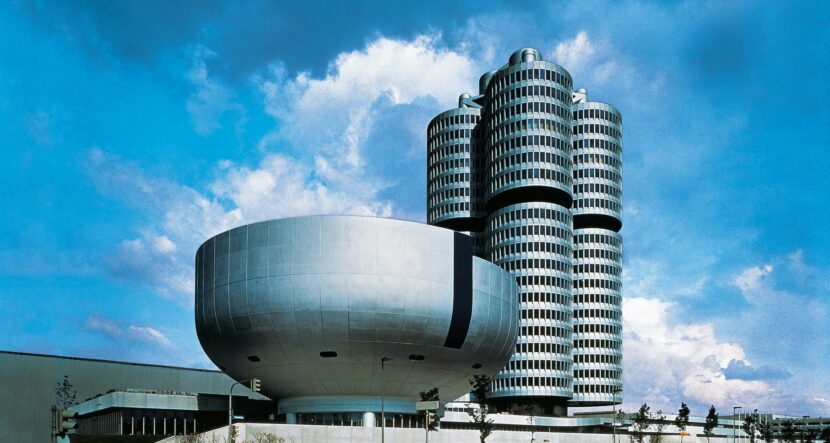For many BMW fans, the BMW Museum is the ultimate destination. Located in Munich just across from BMW Welt, it showcases and contextualizes BMW products throughout the brand’s history. Since 1973 – with a brief closure for renovations from 2004 to 2008 – the BMW Museum has delighted millions of visitors with a true history lesson on the brand. In fact, more than five million visitors have passed through the museum’s doors since it reopened in 2008 alone. Here’s some information on the history and background of the BMW Museum, with an obligatory look at some of the building’s most renowned residents.
1973 – 2004; Original BMW Museum


The first BMW Museum – the iconic bowl-shaped building – was designed by Karl Schwanzer, a Viennese professor and architect. Schwanzer designed the facility to be perfectly round, with the road continuing into an enclosed space. What began in 1922 with a few “souvenirs to be displayed but not sold” in a single room at the Munich plant led to the plant’s own official museum in 1966. Increasing visitor traffic required a purpose-built space to house the exhibitions, and on May 18, 1973, the BMW Museum opened.
The BMW Museum today


As mentioned above, the BMW Museum was closed from 2004 to 2008 for expansion and renovation work. The original BMW Museum is now known as the Museum Bowl. The 1,000 square meter space now serves as a home for temporary exhibitions. In addition, visitors can admire permanent exhibitions on over 4,000 square meters, which include around 110 selected works from the company’s history. Guided tours are offered in German and English. Although the museum is largely under the control of the car manufacturer’s BMW Classic department, it even has its own app.
Another renovation was completed in April 2024, modernizing the lobby and giving it what BMW calls a “futuristic” feel. New ticket machines were introduced, as well as welcoming additions like a plant wall and a more open theme. With these additions, BMW hopes to reduce employee workloads and improve overall accessibility. Exhibits range from celebrating the 100th anniversary of motorcycles to showcasing hydrogen power and circularity. Although the exhibits change, it never gets boring.
The most important BMWs in history


It really never gets old. Here’s one that most people will recognize: a fire-orange E92 M3 GTS. Although it sadly never made it to the U.S., it’s the most aggressive E92 M3 BMW has ever built. Only 150 made it to production. Power has been boosted to 444 horsepower and 325 pound-feet of torque, up 30% each. A roll cage, racing seats, an Alcantara-covered steering wheel, and a fire extinguisher are just some of the added features.


Almost as orange, but nowhere near as fast. Although this 1968 2002 ti lacks the performance credentials of modern cars, it practically invented the term “sports coupe.” A free-revving inline-four engine and just-right size made many contemporary American cars – and European competitors – look old. In more ways than one, the 2002 was a clear winner in dynamics and fuel economy. It also had more space and a much more comfortable cabin.


Perhaps a less comfortable cabin, but who doesn’t love an Isetta? Born out of BMW’s financial crisis in the 1950s, the small car was actually an Italian design licensed by BMW. BMW tweaked some engine components and the badge and made it rip. The “Motocoupe,” as it was marketed, was a hit.


And then there is this BMW 328. It was produced from 1936 to 1940 and is one of the relatively few pre-war vehicles. The coupe had an early inline six-cylinder engine with around 80 hp and accelerated to up to 150 km/h. It was class winner at the 1938 Mille Miglia and the 1939 24 Hours of Le Mans.


And finally, for the Elvis fans out there. This is the real Elvis car, restored by one of the many famous 507 owners by the professionals at BMW Classic. As part of the Haus der Technik exhibition, the car has been extensively restored and even repainted, using contemporary methods rather than modern approaches. This car has been carefully and meticulously restored to factory condition. And it’s not just that – a previous owner had even gone so far as to remove the engine and replace it with a Chevrolet big-block, a hilariously American decision.
If you look through the rest of the album, you’ll find quirky vehicles like the BMW Z1 and its beautiful descendant, the Z8, among others. There’s even a deconstructed i3 and a variety of engines and motorcycles to see. Oh, and Nick Heidfeld’s racing suit from his BMW Sauber days. Like I said – it never gets boring. (Photos: Dan Levins @klapped.media)

